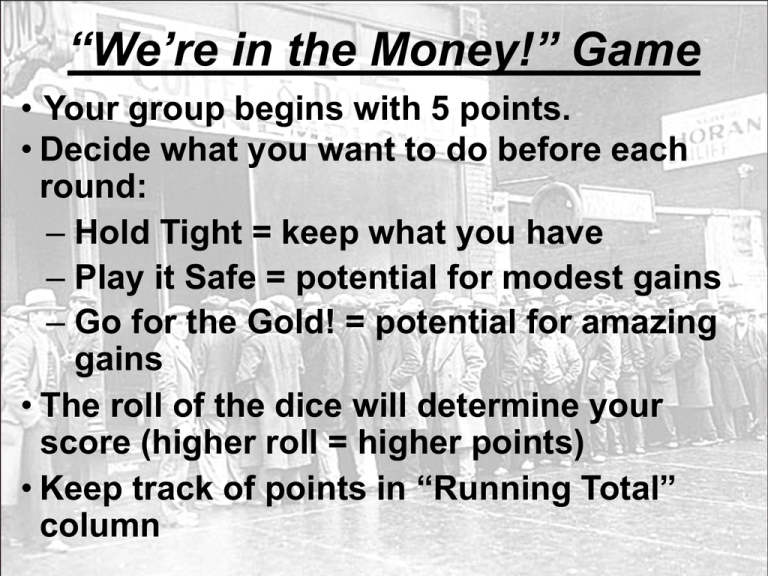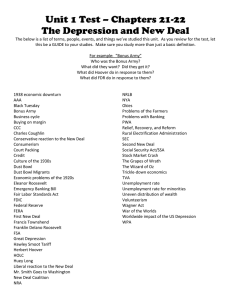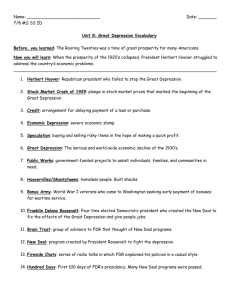THE GREAT DEPRESSION AND THE NEW DEAL
advertisement

“We’re in the Money!” Game • Your group begins with 5 points. • Decide what you want to do before each round: – Hold Tight = keep what you have – Play it Safe = potential for modest gains – Go for the Gold! = potential for amazing gains • The roll of the dice will determine your score (higher roll = higher points) • Keep track of points in “Running Total” column • How did you feel when points were rising? When they dropped dramatically? • Which of the three game options produced the worst results in the end? • How many groups decided to “Go for the Gold!” sometime during the game? Why did some groups make other choices? • Can you think of any time in history when something like this happened? • What is happening in this image? • Who in our game might have ended up here? • How do you think the event depicted here might be related to the overall American economy at the time? essential questions: How did the prosperous 1920s turn into the Great Depression? What is the Great Depression? How did we see prosperity in the 1920s? long-term causes of the Great Depression: 1. overproduction 2. uneven prosperity • Mellon’s tax cut for wealthy 3. farmers suffering • would not recover from 1920-21 recession • 25% of America 4. easy credit (too easy) • 80% no savings • debt rising again today • artificially high stock prices 5. speculation 6. margin buying (a.k.a. buying on margin) 7. laissez-faire government Which of these do we see today? How? the immediate cause of the Great Depression: Black Tuesday: stock market crash • followed Black Thursday • scared investors selling makes things worse video on Black Tuesday The Great Depression: • from stock market crash to World War II • employment and values decrease • bank runs > banks broke > savings gone > banks fail bank run, 1933 • self-perpetuating in a consumer economy because spending is down longer depression less spending and bank deposits • depression is worldwide, though… U.S. loans/investment to Germany G.B. and France buy U.S. goods reparations to G.B. and France …no nation hit as hard as the U.S. Based on the charts shown, add three things that will define the Great Depression: consider: How do you think the Great Depression will affect the lives of Americans? essential question: How did the Great Depression affect American lives? Farmers • many losing land (banks foreclosing when they can’t pay their mortgage; equipment repossessed) • Dust Bowl: over-farming + droughts; these blizzards of dust covered everything, even killing livestock Texas, 1935 • Okies: many farmers were forced to move to cities where they added to the strains on the cities resources Men in the Cities • depression from inability to provide for family, dependence on bread lines bread line at Sixth Avenue and 42nd Street • many became hoboes Families • hard times brought some together, broke others apart (divorce rates down, but mostly due to cost) Minorities • on the one hand, hard times not new • on the other hand, increased discrimination (“last hired, first fired”) Follow-up Assignment: The literature and art of the 1920s showed how bad the situation was. What would your life be like in the Great Depression. Consider using or showing the terms below to write or draw your story. speculation buying on margin Black Tuesday bank run Dust Bowl Okies hobo bread lines consider: What would you want government to do during the Great Depression? essential question: How did Hoover fail in his response to the Great Depression? Herbert Hoover was president from 19291933. • encouraged volunteerism (i.e. asked companies to not lay off workers) because he said the business cycle would fix itself • rejected idea of welfare when Americans were increasingly looking to federal government for direct relief • raised tariffs, causing higher prices due to retaliation from other countries I’m Herbert Hoover. I’m raising tariffs to help get the U.S. out of this depression. OH YEAH?!? I’m Prime Minister MacDonald of Great Britain and I’m raising tariffs too, jerk! • reaction to Hoover included naming signs of poverty after him (i.e. shantytowns = “Hoovervilles”) Empty pockets showing were called “Hoover flags.” • when Hoover did take action, it was too little (Boulder Dam, later named Hoover Dam), too late (Reconstruction Finance Corporation) • the final thing to ensure he would not be reelected was his reaction to the Bonus Army The Bonus Expeditionary Force, more commonly known as the Bonus Army, portrayed Hoover as Kaiser Wilhelm, the leader of Germany during WWI. o veterans marched to Washington, D.C. to demand their bonus early Washington, D.C., police chief Major Pelham Glassford inspecting the camp of the Bonus Army in 1932. o when they did not leave, Hoover had the army force them out, injuring many Tanks and grenades were used by the U.S. Army to disperse the Bonus Army from their encampment at Anacostia Flats, near the U.S. Capitol in 1932. Possible captions: • Many veterans marched to Washington to demand their bonuses early during the Great Depression. • Both black and white veterans marched to Washington to demand direct relief from the government. • The Bonus Army illustrated how people needed direct relief during the Great Depression and were not getting it from Hoover. A caption explains what a picture is showing. Write your own caption for the pictures on the back of your sheet. Mention Hoover in each. The Hot Seat • one person volunteers to be in the hot seat • He or she answers a series of multiple choice questions • 1 question right = sense of self-satisfaction 2 questions right = fist bump 3 questions right = gum 4 questions right = prize box • You have two opportunities to “poll the class” where you can see how the class answered What is shown in the cartoon? Does it present this as a good thing or a bad thing? How can you tell? essential question: How did Franklin Roosevelt respond to the Great Depression? The New Deal: • FDR won the election of 1932 because he was not Hoover • his reform program would be known as the New Deal • first thing FDR did was to declare a bank holiday closing banks to prevent bank runs until the banks could be fixed • New Deal is also called the Hundred Days because that is how long it took for FDR to propose (and Congress to approve) more than 15 new pieces of legislation to fight the Great Depression • New Deal expanded federal government Obama has been compared to FDR because both expanded the federal government. • New Deal relies on deficit spending (borrowing to pay for government programs) • FDR made “direct” contact with Americans with his radio addresses, called “fireside chats” What effects did these radio addresses have? statue at the FDR Memorial in Washington, D.C. link to FDR’s first fireside chat Skim through pages 602-605. In your groups, identify what each of the New Deal measures listed on the sheet (continues onto back) did. Make sure that you feel comfortable with each of these as parts of the New Deal. Below the listing of New Deal programs, categorize them in the following chart: Creating jobs Fixing business, banks, and the stock market Helping farmers Fixing labor relations Providing retirement security Rules for Slaps! • Please remove all hard, sharp, or incendiary objects from your dominant hand. • Lay out the flashcards so that everyone can reach them. • When a term is described, you want to be the first to slap your hand on the card. • Keep each card that you slap first. • Whoever has the most cards at the end of the game wins. consider: Why would anyone think FDR was doing too much? Why would anyone think he wasn’t doing enough? essential question: How did FDR respond to his critics? the critics: • conservatives said the New Deal was an abuse of Presidential power example: Supreme Court ruled New Deal programs such as the NRA and AAA unconstitutional 1932 Supreme Court • liberals said the New Deal did not do enough for average Americans example: Huey Long endorsed a “Share Our Wealth” program that would tax the rich to give money to average Americans example: Father Charles Coughlin was a radio priest that wanted to nationalize industry and banks Father Charles Coughlin, leader of the anti-Semitic Christian Front, delivers a radio broadcast. Detroit, United States, March 11, 1935. How FDR responded to the Supreme Court: • FDR proposed a controversial “court-packing” scheme to add justices to the Supreme Court • both liberals and conservatives hated the plan • did not matter in the end because the most anti-New Deal justices soon retired and the Supreme Court began to support New Deal programs How FDR responded to the liberals: • Second New Deal did more for average Americans Works Progress Administration: created government jobs, many in the arts Wagner Act: protects formation of unions, collective bargaining, and striking (National Labor Relations Board to enforce) Social Security Act: retirement savings, disability payments, and unemployment benefits Look back at your chart categorizing the New Deal programs and add the three 2nd New Deal programs in the proper category. Circle them to indicate that they are part of the 2nd New Deal. Creating jobs Fixing business, banks, and the stock market Helping farmers Fixing labor relations Providing retirement security essential question: How did FDR win the support of women and minorities? Eleanor Roosevelt— changed the role of First Lady to include being active outside the White House; advocate for civil rights Eleanor Roosevelt at Works Progress Administration Negro Nursery School in Des Moines, IA, 1936 Frances Perkins— first woman in the U.S. Cabinet As Secretary of Labor, Perkins was the first woman in the line of succession of the Presidency. Mary McLeod Bethune— advisor in FDR’s Black Cabinet Eleanor Roosevelt and Mary McLeod Bethune, 1937 essential question: What role did the arts play in the Great Depression? some of the arts reflect life (literature, visual arts); others provide an escape from reality (radio and movies) Look through pages 626-631. Find at least two examples of any of the arts (visual art, movies, literature, music, etc.) that reflected life and at least two examples that provided an escape created during the Great Depression to complete the chart below. some of the arts reflect life (literature, visual arts); others provide an escape from reality (radio and movies) Because Eleanor Roosevelt was an ambassador of the New Deal, many people looked to her directly for help. Write a letter to Eleanor from a 1930s American either asking her for help or thanking her. • Use at least three of the terms on the board (also seen on your “Prosperity and Depression” overview page) and underline them when used. • Make sure that you have at least six sentences overall.




